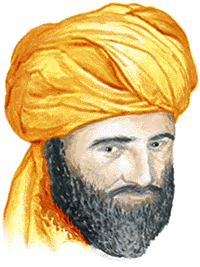...Best of Sicily presents... Best of Sicily Magazine. ... Dedicated to Sicilian art, culture, history, people, places and all things Sicilian. |
by Luigi Mendola | ||
Magazine Index Best of Sicily Arts & Culture Fashion Food & Wine History & Society About Us Travel Faqs Contact Map of Sicily |
Abu Hussain Muhammed ibn Ahmad ibn Jubayr (or Jubair) al-Kenani was born around 1145 in Valencia, then a thriving region of "Moorish" Spain, and by 1182 was high secretary for the Emir of Granada. The following year Jubayr left for a Hajj (pilgrimage) to Mecca. His travels took him across the Mediterranean, reaching Alexandria in Spring 1183. En route back to Spain, in January 1185, he reached Sicily. He described the volcanic Aeolian Islands: "At the close of night a red flame appeared, throwing up tongues into the air. It was the celebrated volcano (Stromboli). We were told that a fiery blast of great violence bursts out from holes in the two mountains and makes the fire. Often a great stone is cast up and thrown into the air by the force of the blast and prevented thereby from falling and settling at the bottom. This is one of the most remarkable of stories, and it is true. As for the great mountain in the island, known as the Jabal al-Nar (Mountain of Fire), it also presents a singular feature in that some years a fire pours from it in the manner of the 'bursting of the dam.' It passes nothing it does not burn until, coming to the sea, it rides out on its surface and then subsides beneath it. Let us praise the Author of all things for His marvellous creations. There is no God but He." His description of Palermo is a vivid one: "It is the metropolis of the islands, combining the benefits of
wealth and splendour, and having all that you could wish of beauty, real
or apparent, and all the needs of subsistence, mature and fresh. It is an
ancient and elegant city, magnificent and He also described the Martorana church, and specifically its bell tower (higher then than now), shown here with the church of San Cataldo, and the city of Messina as predominantly Greek Orthodox (rather than Catholic or Muslim). Jubayr recorded the story of the words of King William II to his subjects following an earthquake in 1169: "Let each of you pray to the God he adores; he who has faith in his God will feel peace in his heart." Yet the subtle storm of religious intolerance was gathering force even in the days of Jubayr's visit, and by the time of the Vespers uprising a century later the Muslims of Sicily had converted to Christianity (usually Catholicism) or departed the island. Jubayr's record is useful for establishing the continuity of the Palermitan cultural atmosphere over the centuries. It is, in effect, a link in a chain. Writing in 972, the geographer Ibn Haukal (actually a merchant from Baghdad with a penchant for writing) described an Arab-Byzantine Sicily in the time long before Idrisi and Jubayr, and a Bal'harm (Palermo) just as prosperous as in the time of Jubayr a century later. Jubayr also visited Jerusalem and other places, and wrote about these. He died in Alexandria in 1217. We do not know precisely what Ibn Jubayr looked like; the painting shown here is speculative. About the Author: One of Sicily's foremost historians, Luigi Mendola is the author of two books. | |
Top of Page |
 Some of the most important descriptions of
Some of the most important descriptions of  gracious,
and seductive to look upon. Proudly set between its open spaces and plains
filled with gardens, with broad roads and streets, it dazzles the eyes with
its perfection. It is a wonderful place, built in the Cordoba style, entirely
from cut stone known as kadhan (limestone). A river splits the town, and
four springs gush in its suburbs... The king roams through the gardens and
courts for amusement and pleasure... The Christian women of this city follow
the fashion of Muslim women, are fluent of speech, wrap their cloaks about
them, and are veiled."
gracious,
and seductive to look upon. Proudly set between its open spaces and plains
filled with gardens, with broad roads and streets, it dazzles the eyes with
its perfection. It is a wonderful place, built in the Cordoba style, entirely
from cut stone known as kadhan (limestone). A river splits the town, and
four springs gush in its suburbs... The king roams through the gardens and
courts for amusement and pleasure... The Christian women of this city follow
the fashion of Muslim women, are fluent of speech, wrap their cloaks about
them, and are veiled."